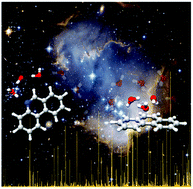How does the composition of a PAH influence its microsolvation? A rotational spectroscopy study of the phenanthrene–water and phenanthridine–water clusters†
Abstract
We report on the noncovalent intermolecular interactions established between the polycyclic aromatic hydrocarbons phenanthrene and phenanthridine with water. Such noncovalent interactions involving extended aromatic systems and water molecules are ubiquitous in a variety of chemical and biological systems. Our study provides spectroscopic results on simple model systems to understand the impact that an extended aromatic surface and the presence of a heteroatom have on the nature of the noncovalent interactions established with the solvent. Microhydrated phenanthrene and phenanthridine clusters with up to three water molecules have been observed and unambiguously characterised by means of broadband rotational spectroscopy and quantum chemical calculations. The presence of a nitrogen atom in the backbone of phenanthridine remarkably affects the geometries of the water clusters and the interaction networks at play, with O–H⋯N and C–H⋯O interactions becoming preferred in the phenanthridine–water clusters over the O–H⋯π interactions seen in the phenanthrene–water clusters. The presence of this heteroatom induces nuclear quadrupole coupling, which was used to understand the cooperativity effects found with increasing cluster size. Our results provide important insight to draw a more complete picture of the noncovalent interactions involving solvent molecules and aromatic systems larger than benzene, and they can be significant to enhance our understanding of the aromatic–polar interactions at play in a myriad of chemical and biological contexts.

- This article is part of the themed collection: 2021 PCCP HOT Articles


 Please wait while we load your content...
Please wait while we load your content...